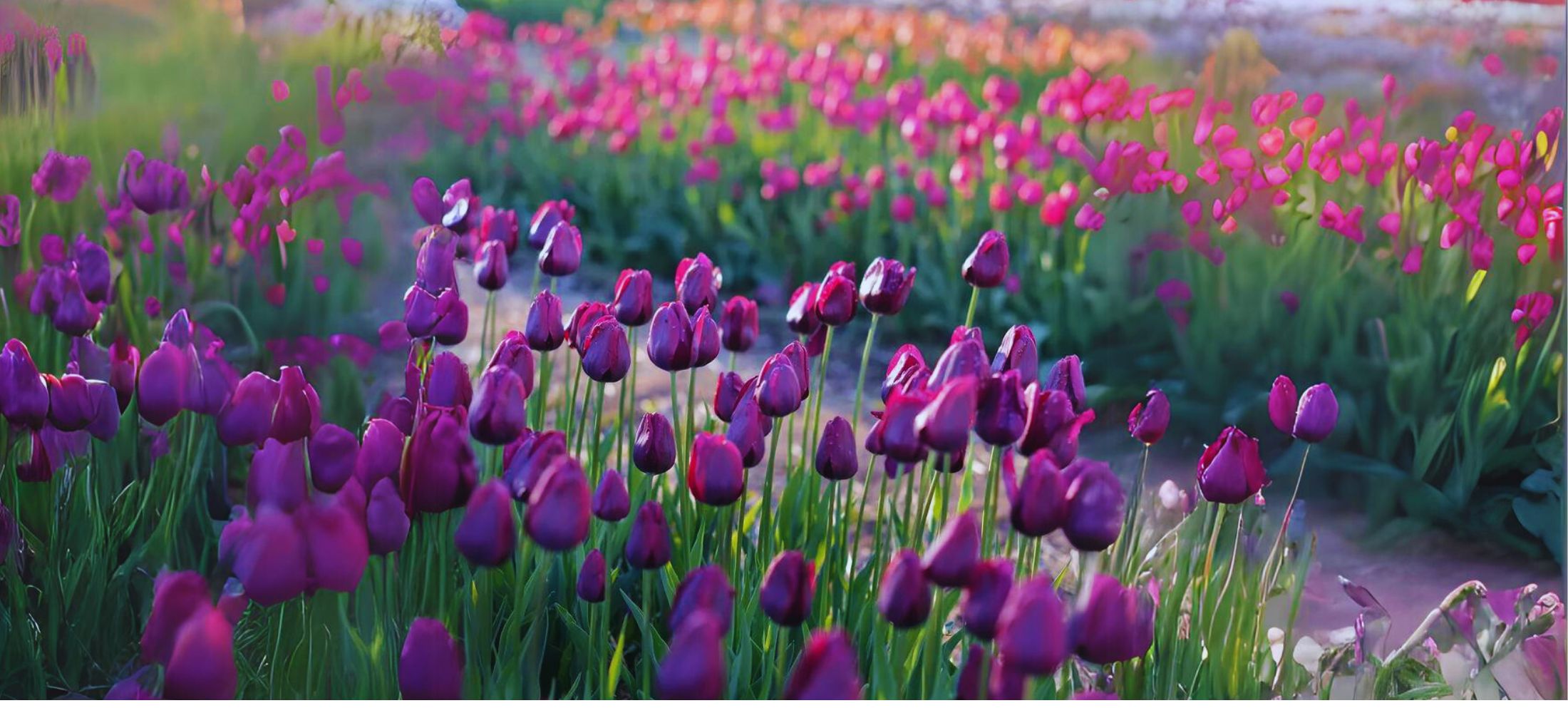Introduction to Queen of the Night Tulip
The Queen of the Night Tulip (Tulipa ‘Queen of the Night’) is one of the most fascinating and mysterious forms of tulips to be had to gardeners. Known for its dramatic, velvety dark pink or near-black blooms, this tulip adds an awesome and highly-priced touch to any lawn mattress or field show.
Although tulips are normally related to shiny, pleased colors, the Queen of the Night offers a putting opportunity that sticks out amongst its opposite numbers. The almost-black petals gleam in the sunlight hours, and their wealthy, velvety texture makes them one of the maximum sought-after tulips for gardeners who need to create a complicated and stylish landscape.
Introduced in the 1940s, Queen of the Night Tulip has constantly been a fave among gardeners and florists alike. It is frequently applied in dramatic garden designs, paired with lighter-coloured tulips, or planted in comparison with light associate plants for a bold assertion.
When Introduced
The Queen of the Night Tulip was delivered to the general public in the mid-20th century, around 1944. Despite its surprisingly cutting-edge origins, it has quickly turned out to be one of the most iconic tulip types. Bred from generations of cautious go-pollination, the Queen of the Night represents decades of tulip breeding, aiming to create the deepest, darkest tulip available.
Where to Plant Queen of the Night Tulip
Queen of the Night Tulips are bendy in phrases in which they’ll be planted, as long as they get hold of the proper growing situations. They thrive great in areas that acquire full solar but can tolerate partial color, in particular in warmer climates.
These tulips are ideal for borders, garden beds, and boxes, wherein their formidable blooms can be showcased. They pair particularly with lighter-coloured vegetation like white, purple, or yellow tulips, offering a dramatic contrast that enhances the beauty of each plant life.
How and When to Plant Queen of the Night Tulip
When to Plant
The first-rate time to plant Queen of the Night Tulips is within the fall, usually amongst September and November, earlier than the floor freezes. Planting in the fall lets in the bulbs to install roots in advance than the winter bloodless units in, leading to more potent plant life inside the spring. The particular planting time depends on your vicinity’s weather—wait until soil temperatures have cooled to around 60°F (15°C) , however they aren’t frozen.
How to Plant Queen of the Night Tulip
Prepare the Soil
Ensure that the soil is well-draining and wealthy in herbs be counted. If your soil is heavy clay, amend it with compost or sand to decorate drainage.
Planting Depth
Dig holes or a trench that is about 6-eight inches deep, that is approximately three instances the peak of the bulb. Space the bulbs about 4-6 inches apart to allow for boom and airflow.
Place the Bulbs
Place the bulbs pointedly within the hollow, and cover them with soil. Gently organize the soil to dispose of air pockets.
Water
After planting, water the bulbs very well to help them settle into the soil. However, keep away from water logging the soil.
Mulch
Apply a layer of mulch to assist insulate the bulbs over iciness and preserve moisture. Mulch moreover enables you to save weeds from sprouting in the spring.
Queen of the Night Tulip Care Tips
Light
Queen of the Night Tulips pick out whole solar, which allows them to grow sturdy and bring huge blooms. Choose an area for your lawn that gets at least 6 hours of direct sunlight each day. While they could tolerate some partial coloration, mainly in warmer areas, too much coloration can bring about fewer flowers and weaker plants.
Soil and Water
These tulips thrive in well-tired soil that is wealthy in nature. They pick impartially to slightly acidic soil, with a pH amongst 6.Zero and seven.0. If your garden soil has a tendency to be heavy or clay-like, it’s crucial to amend it with compost, peat moss, or sand to decorate drainage. This permits you to save you troubles like bulb rot, which could arise if the bulbs sit down in soggy soil for too long.
Regarding watering, Queen of the Night Tulips require slight moisture. After planting, make certain the soil stays wet but now not waterlogged. During the developing season, water them if there are extended dry spells, but make certain the pinnacle inch of soil dries out between waterings.
Temperature and Humidity
Queen of the Night Tulips are hardy in USDA zones three-7, which means they’re able to undergo cold winters, provided they’re planted at the proper time inside the fall. The bulbs require a chilling length to increase nicely and produce blooms inside the spring. As the temperatures rise in spring, these tulips emerge from dormancy, pushing via the soil and unfolding their darkish, velvety petals.
Fertilizer
Fertilizing Queen of the Night Tulips can help make sure strong increase and delightful blooms. Before planting, you could incorporate a balanced, gradual-launch fertilizer into the soil, which offers vitamins because the bulbs set up themselves. A famous-motive bulb fertilizer or one particularly designed for tulips can be effective.
Pruning
Pruning is minimum for Queen of the Night Tulips. After they bloom, it’s vital to allow the foliage to die. The leaves provide electricity to the bulb for the subsequent growing season via photosynthesis. Cut the vegetation off certainly above the foliage to preserve the plant’s look however permit the green leaves continue to be until they turn yellow and wilt.
Pests and Problems
Queen of the Night Tulips, like specific tulips, may be prone to some pests and illnesses. Common pests encompass:
- Aphids: These small, sap-sucking insects can harm the foliage and transmit ailments. If you note aphids, spray the plant life with a robust drift of water or use insecticidal soap.
- Tulip Bulb Maggots: These pests can burrow into the bulbs, inflicting decay. To prevent infestations, rotate your planting places and avoid overwatering.
- Spider Mites: In dry situations, spider mites can thrive and cause harm to leaves. Regularly misting the foliage can assist keep humidity and deter those pests.
Queen of the Night Tulip Companion Plants
Pairing Queen of the Night Tulips with the proper companion plant life can enhance their splendor and create a lovely garden display. Consider those partner flowers:
- White Tulips: White tulips offer a stunning comparison to the dark colorings of the Queen of the Night, creating a conventional and fashionable look. Varieties like ‘Mount Tacoma’ or ‘Purissima’ artwork extraordinarily.
- Bleeding Heart (Dicentra): This perennial’s touchy purple flowers and fern-like foliage provide a lovely contrast in each color and texture.
- Forget-Me-Nots (Myosotis): These small blue flora create a high-quality impact at the same time as planted alongside dark tulips, adding a touch of color.
- Hostas: The lush foliage of hostas offers a cute backdrop to the tulips and enables fill within the lawn vicinity as quickly because the tulips have completed blooming.
- Ferns: Ferns can provide a nice textural assessment and thrive in similar conditions, helping to create a lush, layered appearance on your lawn.
6 Facts About Queen of the Night Tulip
There Are Thousands of Varieties of Tulips
Queen of the Night Tulip belongs to the Liliaceae own family and comes in a large array of colors, shapes, and sizes. There are over 3,000 registered tulip kinds, each with specific traits, making them a face amongst gardeners worldwide.
Tulips Have an Expensive History
Queen of the Night Tulips were as soon as considered a costly item inside the 17th century, sooner or later of a length referred to as “Tulip Mania.” Prices for uncommon bulbs skyrocketed, mainly to a speculative market that in the long run crashed, making tulips a photo of wealth and extravagance.
The Flowers Are Edible
Tulips are not in reality beautiful; they are also match for human consumption! The petals may be applied in salads, and the bulbs may be cooked and eaten, even though care has to be taken to make sure they’re free of insecticides and exclusive chemical substances.
Each Tulip Color Has a Different Meaning
The shade of Epiphyllum oxypetalum includes various meanings. For instance, red tulips represent love, whilst yellow tulips constitute cheerfulness. Purple tulips often denote royalty and elegance, making Queen of the Night a notable desire for conveying luxurious.
There Is a Near-Black Variety

The Queen of the Night Tulip is frequently identified for its nearly black petals, which upload a dramatic contact to gardens. This deep hue can seem more pink or black depending on the lights, making it a completely unique addition to any tulip series.
Blooms Only Last 7 to 10 Days
Tulips have an enormously short blooming duration, generally lasting approximately every week to ten days. This brevity makes them all of the greater treasured, as gardeners eagerly appear beforehand to their arrival each spring.
Conclusion
The Queen of the Night Tulip isn’t most effective a lovely addition to any lawn however additionally an image of beauty and intrigue. With its deep, velvety petals and costly appearance, it captivates all and sundry who lays eyes on it. Understanding the manner to plant, care for, and propagate this exceptional tulip variety will ensure that you may experience its beauty 12 months after twelve months.
Read more: How to grow lupine: Comprehensive guide




Did you know that Queen of the Night Tulips have a near-black variety? What makes these tulips unique compared to other varieties?